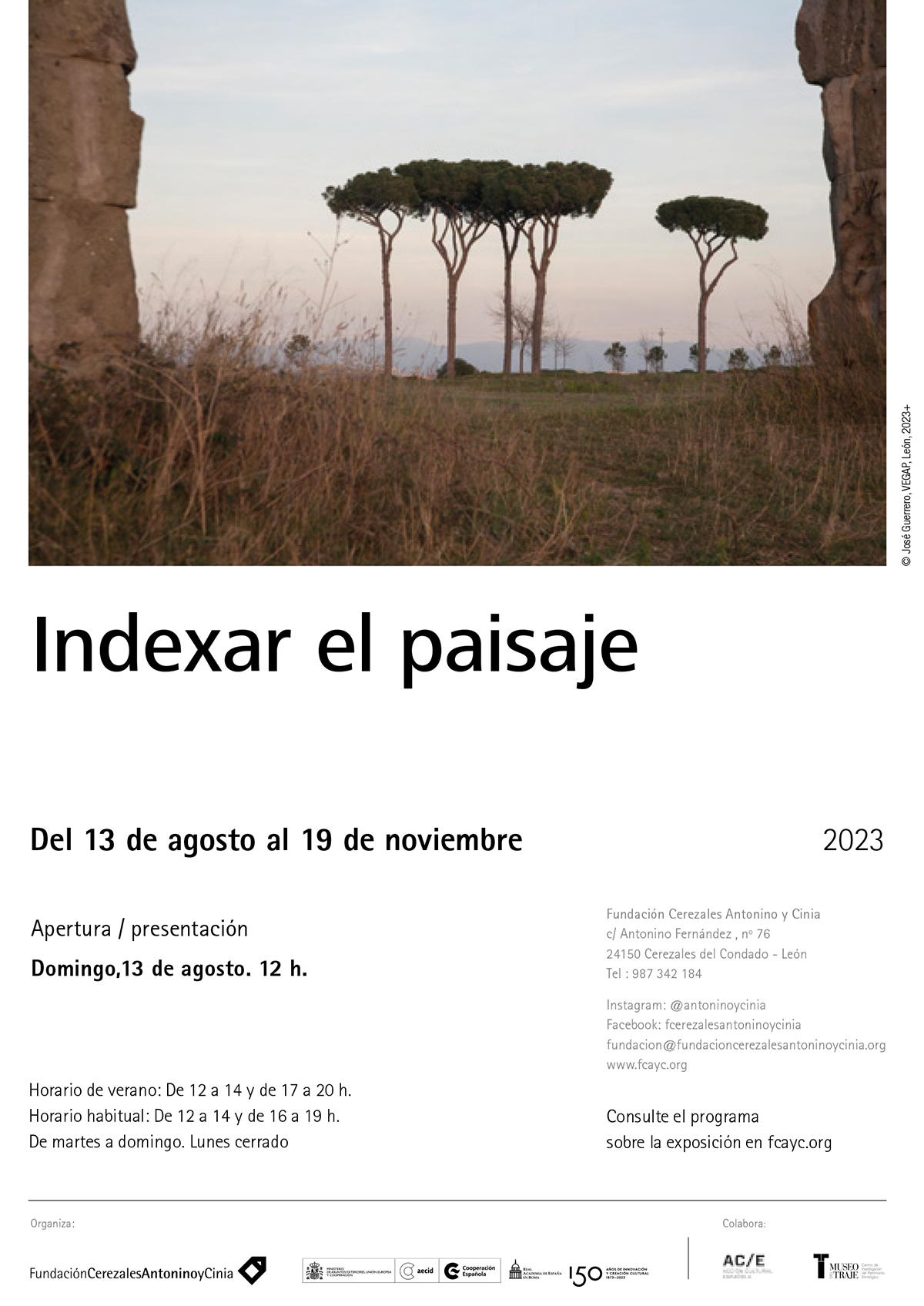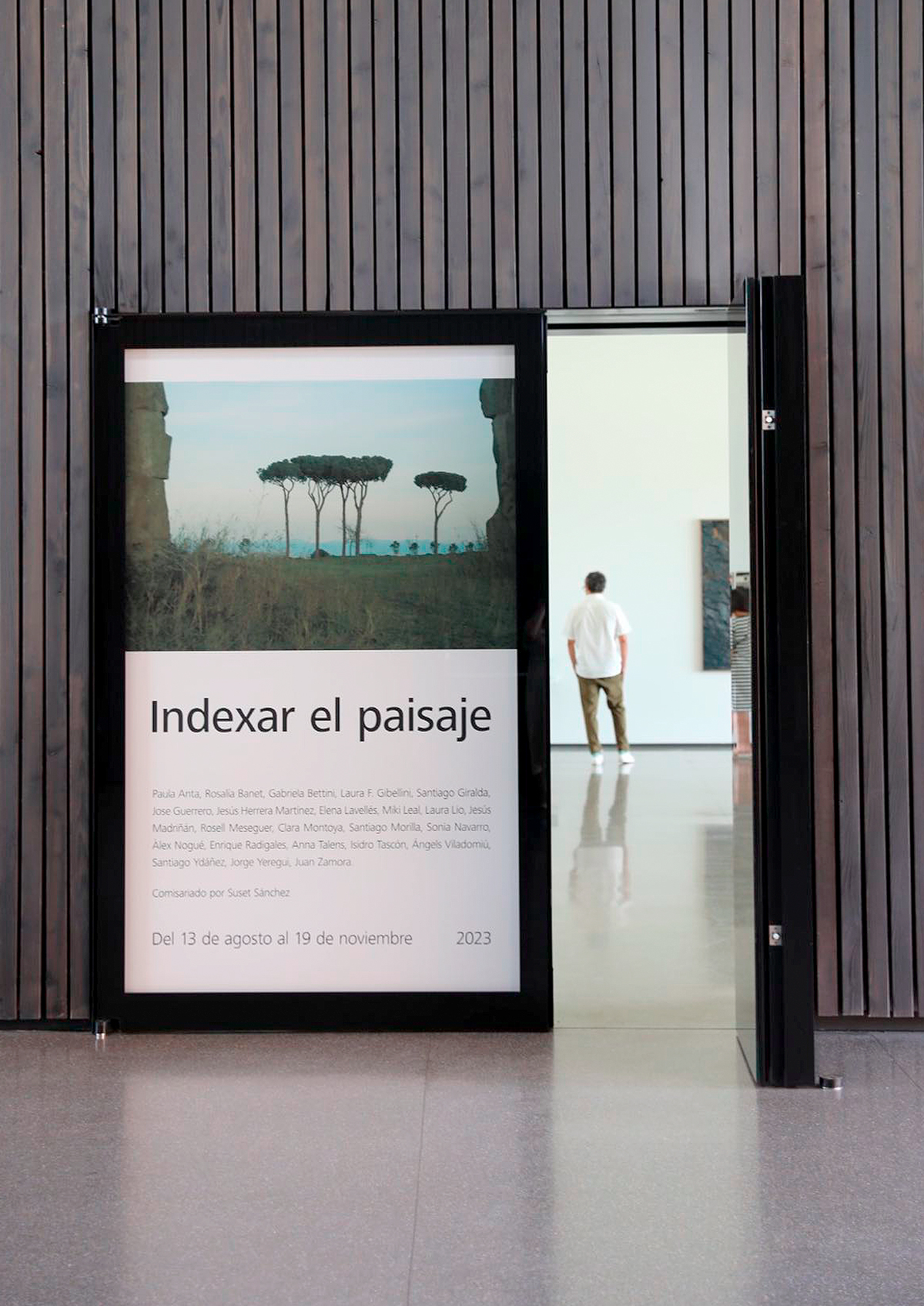Ritual
device for fungal humus culture. Everyone should be a musician, a dancer, and a fungus farmer (at the same time) @ ARS ELECTRONICA 2025
“Ritual device for fungal humus culture” will be presented at the Theme Exhibition “PANIC: Complex. Absurd. Ominous”, curated by Manuela Naveau, within the Ars Electronica Festival 2025 in Linz (Austria).
The exhibition addresses the political, technological, and ecological forces that generate collective fear and disorientation, while also inviting us to rethink panic as a space for reflection and transformation. Within this framework, the projects developed through the Tilling Roots and Seeds program engage with biodiversity, interspecies relations, and speculative approaches to sustainable futures.
An art project developed during the Tilling Roots and Seeds residency. It consists of a device for cultivating and biosonifying saprophytic fungi, envisioning future systems of biodiversity and sustainable food production.
︎︎︎ Theme Exhibition: “PANIC: Complex. Absurd. Ominous”
︎︎︎ When: September 3–7, 2025
︎︎︎ Where: POSTCITY, Bunker | Linz (Austria)
︎︎︎ Curated by: Manuela Naveau
︎
This art-based research asks what it means to care for soil today, and how that care can shape the way we grow, eat, and coexist with other forms of life. In this context, fungi emerge as key indicators of biodiversity, revealing the essential role of interspecies collaboration in sustaining nutrient cycling and ecological processes.
The installation presents the audience with a garden-synthesizer sound device designed for the cultivation and biosonification of saprophytic fungi. This interactive environment transforms fungal growth into a responsive soundscape. The audience's presence is detected through sensors in the soil, converting their gestures into music—shaped and modulated by the fungi's own electrical activity– and creating a state of synaptic and performative empathy with their surroundings.
Here, soil is no longer a passive surface, but a living, responsive partner—one that invites us to listen, interact, and recognize ourselves as part of a shared ecological network.
MORE ︎ HERE
︎︎︎ Concept and Art Direction: Santiago Morilla.
︎︎︎ Created within the residency program of the Tilling Roots and Seeds project, developed in collaboration with Ferrer Sustainability, Tectum Garden, Món Sant Benet – Fundació Catalunya La Pedrera, and Fundación Contorno Urbano.
︎︎︎ With the support of Quo Artis Foundation, the Dept. of Culture of the Government of Catalonia, and the Barcelona City Council.
︎︎︎ Physical Computing, Interactive Design and Software Development: Joaku de Sotavento & Fernando Fernández.
︎︎︎ Music, Field Recordings and Soundscape Design: Santiago Morilla and Joaku de Sotavento (with the special vocal collaboration of Coco Moya).
︎︎︎ Hardware Design and Construction: Santiago Morilla, Olly Needham and Nicholas Burridge.
︎︎︎ Fungi Suppliers (collaborators): Fungi Natur (Santolaya de Cabranes).
︎︎︎ Academic support: Research group arte-conocimiento.com, Universidad Complutense de Madrid.
︎ 03-08/Sept./25

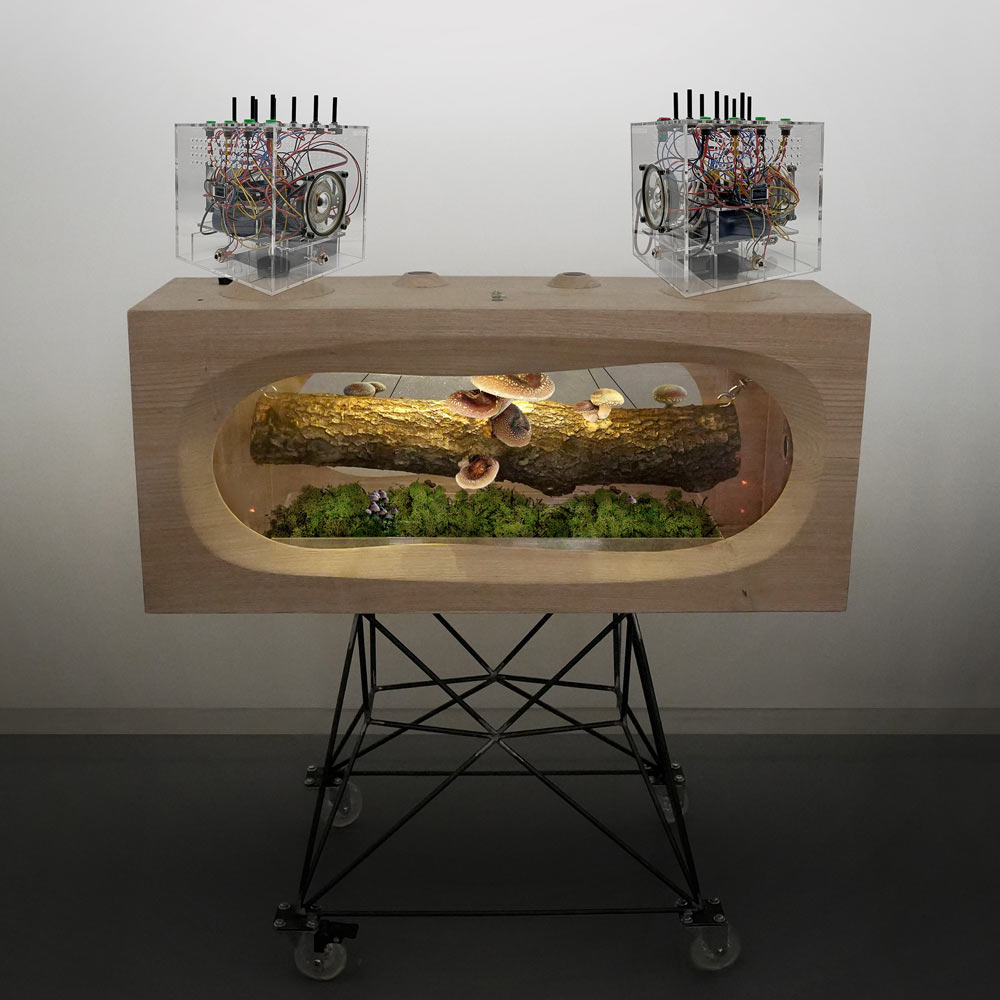
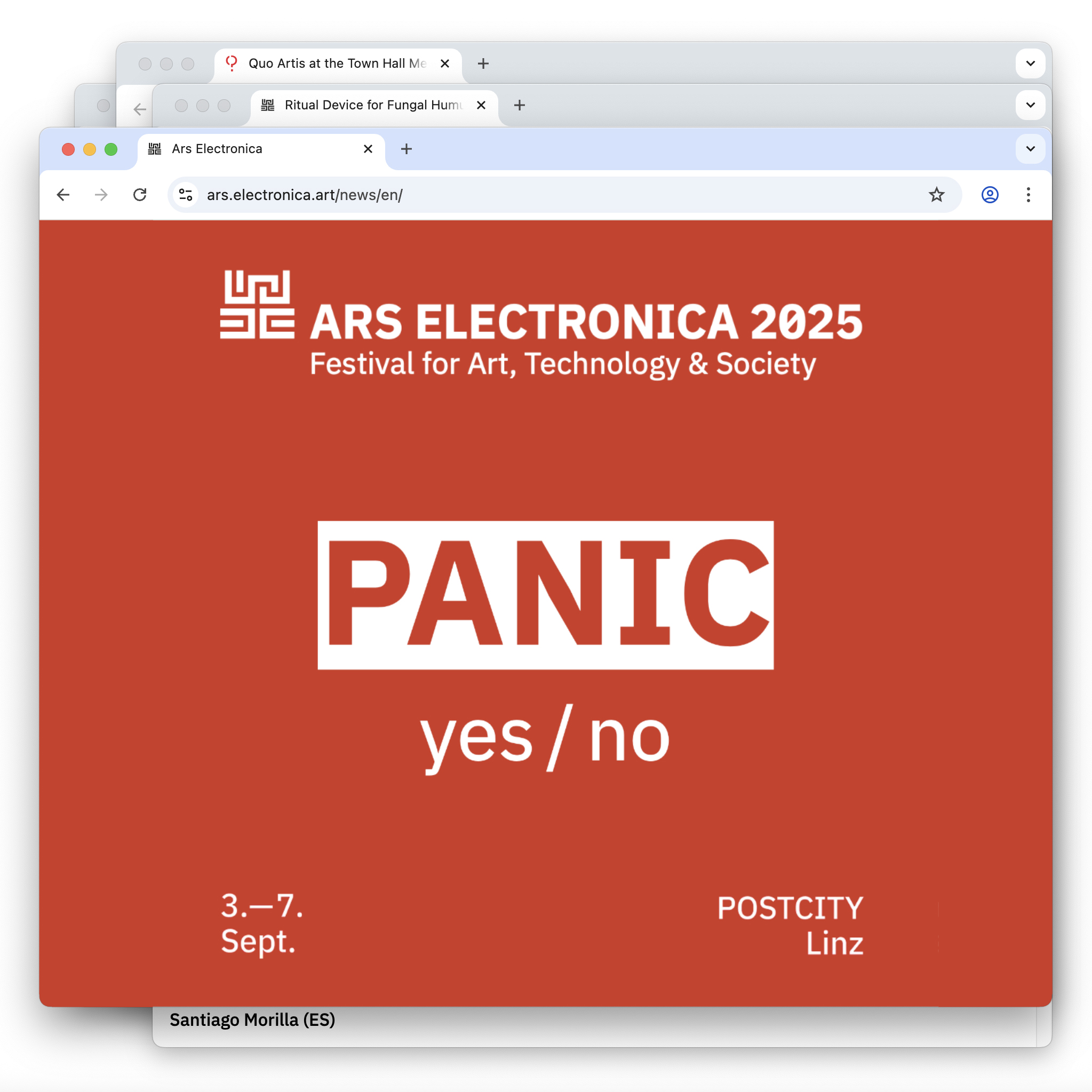

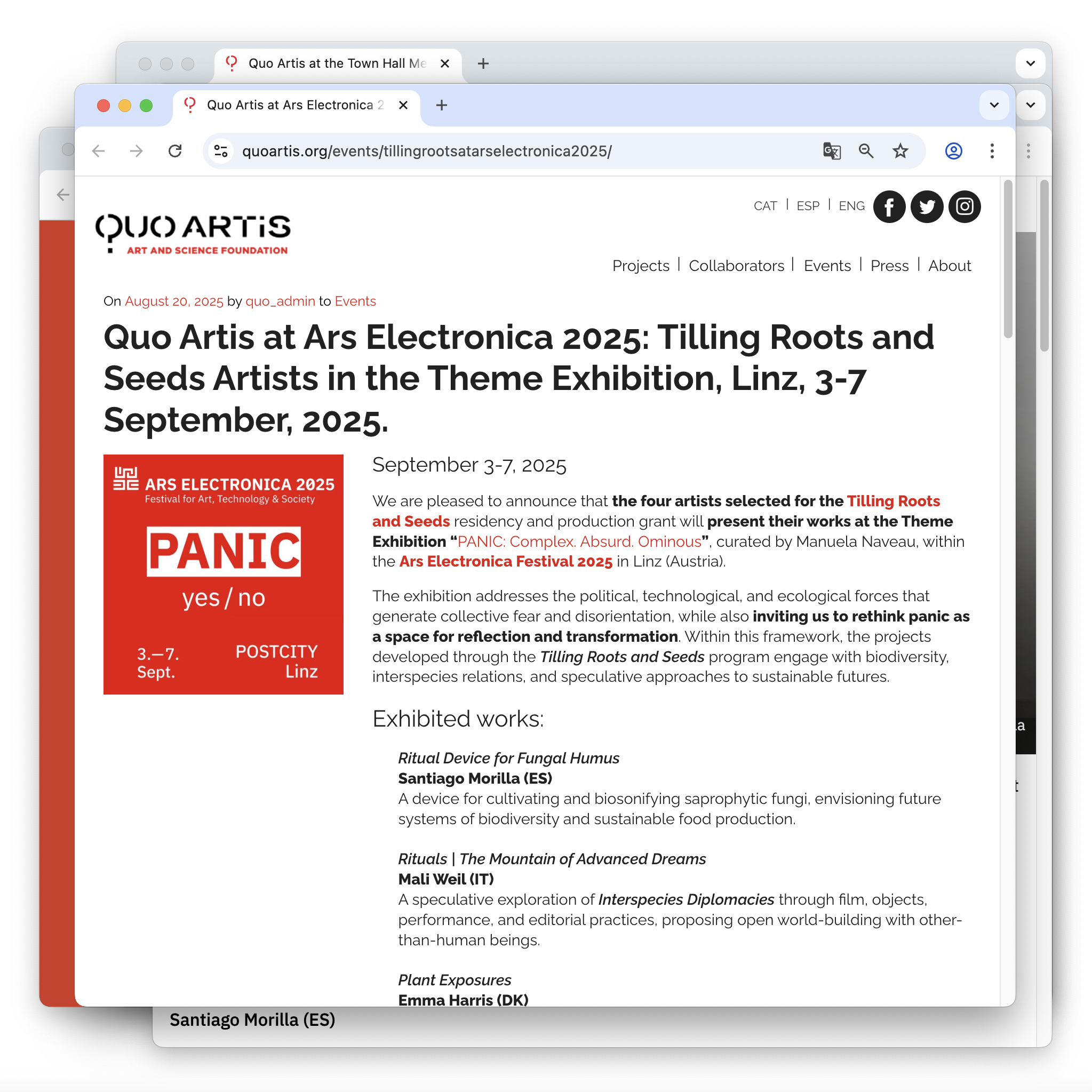
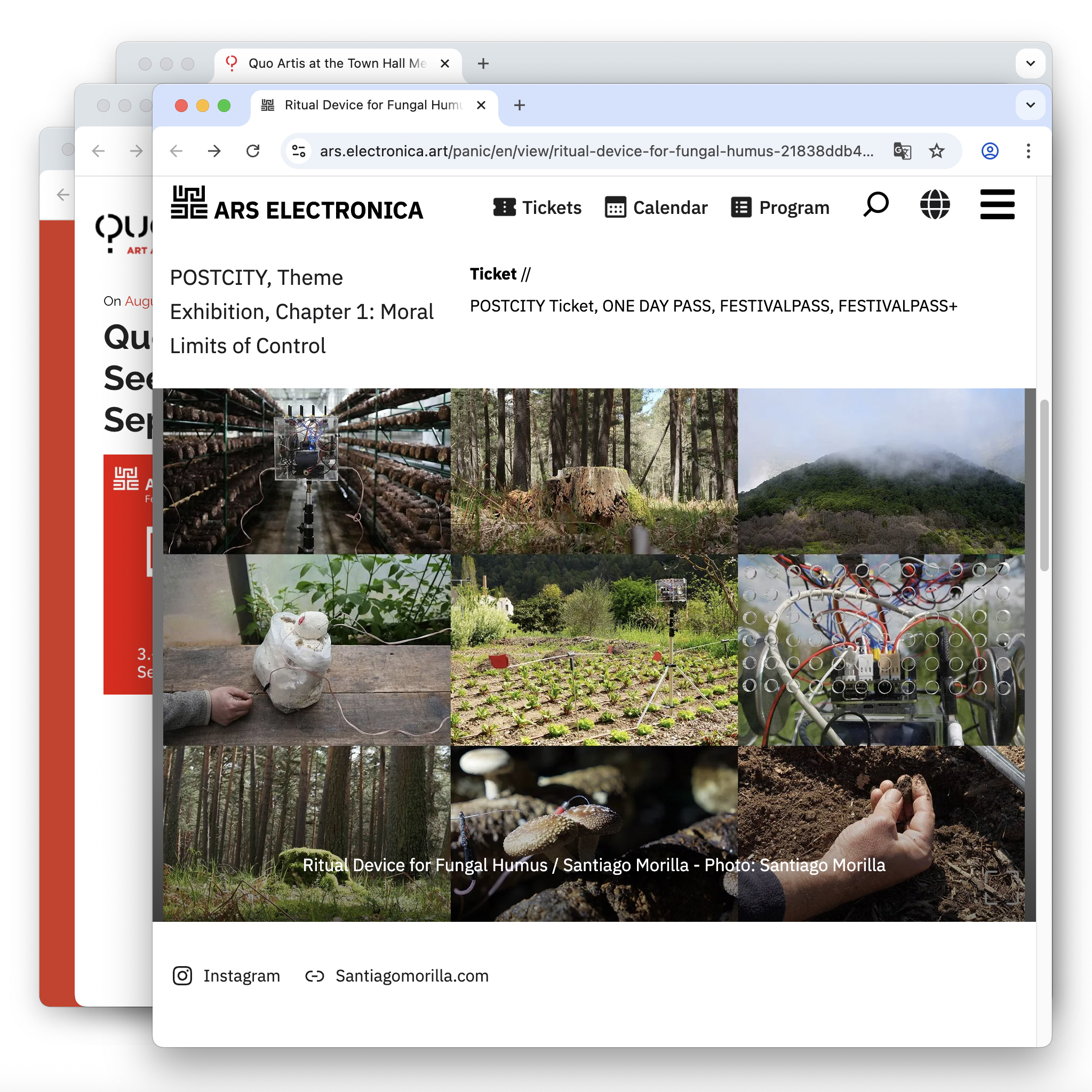
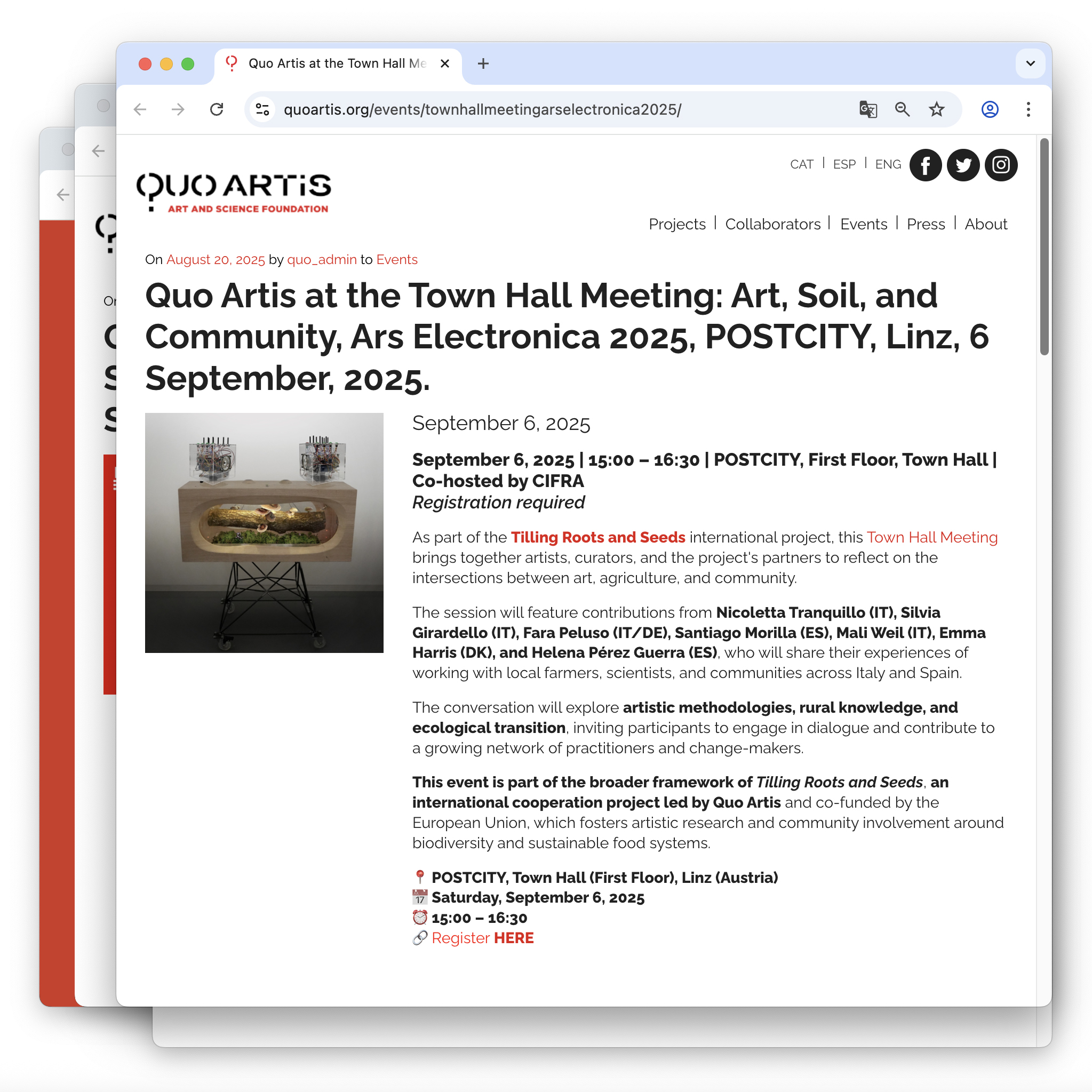
The inherent is to tremble. A forensic memory of vibrant matter (art award and collective exhibition)
My installation “The inherent is to tremble. A forensic memory of vibrant matter” (v2.0, 2024) selected from 816 proposals, has received the Ciutat de Palma Antoni Gelabert award for visual arts 2024, currently on display at Casal Solleric, Palma, Spain (until 09/03/25)
“The inherent is to tremble” stems from a visit to the abandoned pediatric psychiatric hospital of La Motte au Duc in Rennes (France), a site marked by disuse, fading memory, and ongoing gentrification. Struck by the erasure of its past, Morilla developed an artistic research project that explores destruction, memory, and institutional violence.
The installation’s title references both the trembling of a building being demolished and the tremors of the vulnerable children who once inhabited it, subjected to structural violence. Combining graphic and sound documentation, the multimedia installation features a kinetic sound sculpture made from hospital chairs—bearing traces of their former users—and a 10-minute video reflecting on the ghosts of the physical and digital world. Google Earth and Google Maps were also used to track the site's transformation, weaving together digital and physical imprints into a layered narrative of loss and resilience.
︎︎︎ Site: Casal Solleric, Palma, Spain
︎︎︎ Jury of the award: Magdalena Aguiló, Eva Lootz, Jordi Pallarés.
...
"Lo propio es temblar. Memoria forense de la materia vibrante" (v2.0, 2024), Premi Ciutat de Palma Antoni Gelabert d’arts visuals 2024, actualmente expuesto en el Casal Solleric (20/01-09/03/25)
Esta instalación es el resultado de una investigación realizada en La Motte au Duc, un antiguo hospital pediátrico de la ciudad de Rennes (Francia) especializado en el tratamiento de trastornos mentales infantiles. Un espacio rodeado de extensas zonas arboladas, con pinos, abetos y cedros centenarios, que, a partir de 2021, ha sido objeto de una importante y apresurada operación de especulación inmobiliaria. Hoy, en 2025, el hospital y sus arboledas circundantes han desaparecido casi completamente, y con ellas también su memoria vibracional. El montaje audiovisual entrelaza la documentación obtenida in situ con ficciones vegetales de realidad aumentada y derivas digitales reapropiadas desde Google Street View, Maps y Earth. La dispositivación en sala se completa con una escultura cinética adaptada a partir de dos sillas abandonadas en un rincón del hospital que, ahora, se presentan mecanizadas y sonificadas con micrófonos de contacto; dos testigos materiales del ruido tecnoeconómico y de la violencia sobre los cuerpos más frágiles que, como capas materiales e informacionales superpuestas, condicionan, interrumpen y perturban la experiencia perceptiva del conjunto de la instalación. El arte, aquí, entre temblores y demoliciones, se presenta como un ejercicio de memoria forense.
Agradecimientos: @anapuech (por su apoyo y locución en francés); @estrellafugazmusic (por su generosidad y sensibilidad musical); CAPS Ecole universitaire de recherche, Rennes, Francia (por su logística y ayuda en la investigación); Jose Antonio Jiménez Corona (por su ayuda en la mecánica y sonificación)
︎ 20/01-09/03/25








Travelling cycle-biotope for ants, plants and humans (site-specific installation)
This large-format installation is designed to be carried by a bicycle or a motorbike. In its static indoor version, two bicycle machines invite spectators to pedal and pump water from the lower tank to the upper tank (where plants filter the water). From there, the water cycle is distributed through two lateral anthills and a central urn, which serves as a feeding box for ants. The installation encourages us to physically and playfully interact with the small ecosystem, participating in its maintenance.
Can we humans imagine ourselves caring for a colony of Messor Barbarus ants and a plant ecosystem in a symbiotic relationship? This installation, specifically designed for the Science and Water Museum of Murcia, aims to explore the role of human participation in such ecosystems. This innovative installation also attempts to highlight the role of situated technologies as a vital component in the ecosystemic balance and, at the same time, points to the capacity of artistic practice to generate new imaginaries of inter-species assistance.
︎︎︎ Site: Museum of Science and Water, Murcia, Spain.
︎︎︎ Curators: Miguel Mesa del Castillo and Enrique Nieto.
︎ Mixed technique installation: Iron structure (320 cm high, 170 cm wide, 170 cm deep) with two water cyclobombs, piping system, methacrylate urns, plants, geotextile, sand and clay, substrate and filters, two anthills with colonies of Messor barbarus ants.
...
Esta instalación de gran formato está preparada para ser remolcada por una bici o moto. En su versión estática interior, dos bici- máquinas invitan a los espectadores a pedalear y bombear agua desde el tanque inferior hasta el tanque superior (donde unas plantas acuáticas filtran el agua). Desde ahí, el agua sigue su ciclo distribuyéndose para hidratar dos formicarios laterales y regar de nuevo la urna central, que hace las veces de caja de forrajeo para las hormigas. La instalación nos invita al compromiso físico y lúdico con el pequeño ecosistema, participando así de su mantenimiento durante el tiempo de exposición.
¿Podemos imaginarnos cuidando de una colonia de hormigas Messor Barbarus y de un ecosistema vegetal en relación simbiótica? Esta instalación, específicamente diseñada para el Museo de la Ciencia y el Agua de Murcia, quiere explorar el papel de la participación humana en dichos ecosistemas. Además, pretende destacar el papel de las tecnologías situadas como un componente vital en el equilibrio ecosistémico y, al mismo tiempo, apuntar la capacidad de la práctica artística para generar nuevos imaginarios de cuidado interespecie.
︎︎︎ Lugar: Museo de la Ciencia y el Agua, Murcia, España.
︎︎︎ Comisarios: Miguel Mesa del Castillo y Enrique Nieto.
︎ Instalación específica en técnica mixta: Estructura de hierro (320 cms alto, 170 cms ancho, 170 cms fondo). Dos ciclo-bombas de agua, sistema de tuberías, dos urnas de metacrilato y carpintería metálica, plantas, geotextil, arena y arcilla, sustrato y filtros, dos hormigueros con dos colonias de hormigas Messor barbarus.
︎ 25/07/2024











Mirmecologías / Myrmecologies (solo exhibition)
Exposición individual "Mirmecologías. Afinidades entre hormigas, plantas, humanos y máquinas" en el Centro Párraga (Espacio 2), Murcia.
Proyecto comisariado por Miguel Mesa del Castillo y Enrique Nieto.
Del 14/03/2024 hasta el 25/04/2024
Mirmecología es la rama del conocimiento que se ocupa del estudio de las hormigas y de su impacto en los ecosistemas. Así, en un sentido más amplio, alude también a las asociaciones mutualistas y a otras interacciones antagónicas posibles, como el comensalismo o incluso el parasitismo interespecies. Es decir, una hormiga cuidando a una oruga de un licénido. ¿Pero, podemos imaginar a un humano cuidando de una colonia de hormigas Messor Barbarus que, a su vez, cuida de un ecosistema vegetal en relación simbiótica?
Esta exposición quiere explorar cómo las hormigas y las plantas han evolucionado juntas para desarrollar una relación que beneficia a ambas partes. Por ejemplo, algunas especies de hormigas son esenciales para la polinización y dispersión de semillas y también protegen a las plantas de los depredadores, mientras que las plantas, por su parte, proporcionan alimento y refugio a las hormigas. Pero además, esta exposición quiere explorar el papel de la participación humana en dichos ecosistemas y destacar, por un lado, el papel de las tecnologías situadas en su comprensión como un componente vital en su equilibrio y, por otro lado, la capacidad de la práctica artística para generar nuevos imaginarios de participación y cuidados interespecies.
+ INFO: CENTRO PÁRRAGA
︎ 14/03-25/04/2024

Indexar el paisaje / Indexing the Landscape (collective exhibition)
“Indexing the Landscape” collective exhibition at Fundación Cerezales Antonino y Cinia (León)
From 13 August to 19 November 2023.
LANDSCAPE, SCRAWLS, LANGUAGE (txt by Suset Sánchez)
As far back as the genetic images preserved in Paleolithic cave paintings there are signs of the indissoluble relationship between sapiens and surrounding nature; as well as a recurring procedure by which the perception of the exterior is very often, albeit not exclusively, represented in an interior space, protected from a host of dangers and the effects of weather, whether it be a prehistoric cavern or the essential forms of an ancient proto-dwelling. The translation of the gaze on the landscape, the vision of the knowable world, has been projected ever since then in motifs, icons, symbols and graphic systems, in inscriptions and morphologies, all stemming from an imperative need for social organisation, conservation and transmission of knowledge.
This ancestral gesture of recording through images the inhabited and traversable places, of gathering data and developing a complex network of signs through which to identify those contexts and indicate the distinctive elements of each place, gave rise to the creation of taxonomies whose purpose was to conceptualise and to make functional the spatial categories and metaphors that would describe the territory and the transformations wrought in it by human beings in their day-to-day activity.
Santiago Morilla set out to discern how techno-artistic interventions modify and expand the perception of the cultural/natural landscape. By inviting us to interact with a theremin filled with sheep shearings, he enables us to redimension the view of El Barrueco de Abajo reservoir in Malpartida, where the sounds and images that are now reproduced in the exhibition hall were recorded. Through performativity, sound experimentation and the playful nature of this installation. and under a docile symbolism, the artist reports on the instrumentality of technologies in post-industrial societies in facilitating control of the social herd and the domestication of nature.
+ INFO: FCAYC
Curated by Suset Sánchez Sánchez.
Artists: Laura F. Gibellini, Laura Lio Martorelli, Jose Guerrero, Clara Montoya, Jesús Madriñán, Santiago Ydañez, Miki Leal, Santiago Giralda, Álex Nogué, Jesús Herrera Martínez, Gabriela Bettini, Anna Talens, Enrique Radigales, Isidro Tascón, Rosell Meseguer, Santiago Morilla, Sonia Navarro, Paula Anta, Jorge Yeregui, Juan Zamora, Ángels Viladomiú, Elena Lavellés, Rosalía Banet.
Organised by The Royal Academy of Spain in Rome Fundación Cerezales Antonino y Cinia.
...
Exposición colectiva "Indexar el paisaje" en la Fundación Cerezales Antonino y Cinia (León)
Del 13 de agosto al 19 de noviembre de 2023
PAISAJE, GARABATOS, LENGUAJE (txt de Súset Sánchez)
Desde las genésicas imágenes conservadas en las pinturas rupestres paleolíticas, existen señales de la indisoluble relación entre sapiens y naturaleza circundante; así como de un recurrente procedimiento por el cual la percepción del espacio exterior es representada muchas veces, aunque no exclusivamente, en interiores —al resguardo de peligros múltiples y de los efectos del clima—, sean estos las prehistóricas cavernas o las formas esenciales de las antiguas proto-viviendas. La traducción de la mirada sobre el paisaje, la visión del mundo cognoscible, se proyecta desde entonces en motivos, iconos, símbolos, sistemas gráficos, en inscripciones y morfologías que surgen de una perentoria necesidad de organización social, conservación y transmisión del conocimiento.
Ese gesto ancestral de registrar por medio de imágenes los lugares habitados y transitables, de recopilar datos y elaborar una compleja red de signos mediante los cuales identificar esos contextos e indicar los elementos distintivos de cada paraje, conllevó la creación de taxonomías con el objetivo de conceptualizar y hacer funcionales las categorías y metáforas espaciales que describirían el territorio y las transformaciones operadas en el mismo por el ser humano en su cotidiana actividad.
Santiago Morilla propone discernir cómo las mediaciones tecno-artísticas modifican y expanden la percepción del paisaje cultural/natural. Invitándonos a interactuar con un theremin con piel de oveja, podremos redimensionar la visión del Embalse de El Barrueco de Abajo en Malpartida, donde fueron registrados los sonidos y las imágenes que ahora se reproducen en la sala de exposiciones. A través de la performatividad, la experimentación sonora y el carácter lúdico de esta instalación; y bajo un simbolismo dócil, el artista informa sobre la instrumentalidad de las tecnologías en las sociedades postindustriales que facilitan el control del rebaño social y la domesticación de la naturaleza.
+ INFO: FCAYC
Comisariado: Suset Sánchez
Artistas: Laura F. Gibellini, Laura Lio Martorelli, Jose Guerrero, Clara Montoya, Jesús Madriñán, Santiago Ydañez, Miki Leal, Santiago Giralda, Álex Nogué, Jesús Herrera Martínez, Gabriela Bettini, Anna Talens, Enrique Radigales, Isidro Tascón, Rosell Meseguer, Santiago Morilla, Sonia Navarro, Paula Anta, Jorge Yeregui, Juan Zamora, Ángels Viladomiú, Elena Lavellés, Rosalía Banet.
Organiza: Real Academia de España en Roma y Fundación Cerezales Antonino y Cinia.
︎ 13/08-19/11/2023
